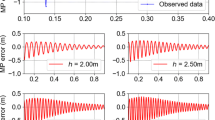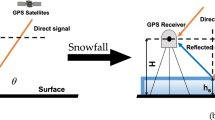Abstract
Multipath in global positioning system (GPS) is the interference of the microwave signals directly from satellites and those reflected before reaching the antenna, typically by the ground. Because reflected signals cause positioning errors, GPS antennas are designed to reduce such interference. Recent studies show that multipath could be utilized to infer the properties of the ground around the antenna. Here, we report one such application, i.e. a fixed GPS station used as a snow depth meter. Because the satellite moves in the sky, the excess path length of reflected waves changes at rates dependent on the antenna height. This causes quasi-periodic variations of the amplitude and phase of the received signals. Accumulation of snow reduces effective antenna heights, and we can see it by analyzing multipath signatures. Signal-to-noise ratios (SNR) are often used to analyze multipath, but they are not always available in raw GPS data files. Here, we demonstrate that the geometry-free linear combination (L4), normally used to study the ionosphere, can also be used to analyze multipath signatures. We obtained snow depth time series at a GPS station in Hokkaido, Japan, from January to April in 2009 using L4 and SNR. Then, we compared their precisions. We also discuss mechanisms responsible for the possible underestimation of the snow depth by GPS. Finally, we investigate the possibility of inferring physical conditions of the snow surface using amplitudes of multipath signatures.
Similar content being viewed by others
References
Bilich AL, Larson KM, Axelrad P (2008) Modeling GPS phase multipath with SNR: case study from the Salar de Uyuni, Bolivia. J Geophys Res 113: B04401. doi:10.1029/2007JB005194
Eloségui P, Davis JL, Jaldehag RK, Johansson JM, Niell AE, Shapiro B (1995) Geodesy using the global positioning system: the effects of signal scattering. J Geophys Res 100: 9921–9934
Heki K, Ping JS (2005) Directivity and apparent velocity of the coseismic ionospheric disturbances observed with a dense GPS array. Earth Planet Sci Lett 236: 845–855. doi:10.1016/j.epsl.2005.06.010
Hino M (1984) Spectrum analysis. Asakura-Shoten, Tokyo, pp 300 (in Japanese)
Hofman-Wellenhof B, Lichtenegger H, Collins J (2001) GPS—theory and practice, 5th edn. Springer, New York, p. 382
Iizaka J (1998) Handbook of synthetic aperture radar images—new technique in Earth’s environment measurement. Asakura-Shoten, Tokyo, p 208 (in Japanese)
Kedar S, Hajj GA, Wilson BD, Heflin MB (2003) The effect of the second order GPS ionospheric correction on receiver positions. Geophys Res Lett 30: 1829. doi:10.1029/2003GL017639
Larson KM, Small EE, Gutmann ED, Bilich AL, Axelrad P, Braun JJ (2008) Using GPS multipath to measure soil moisture fluctuations: initial results. GPS Sol 12: 173–177. doi:10.1007/s10291-007-0076-6
Larson KM, Small EE, Gutmann ED, Bilich AL, Braun JJ, Zavorotny VU (2008) Use of GPS receivers as a soil moisture network for water cycle studies. Geophys Res Lett 35: L24405. doi:10.1029/2008GL036013
Larson KM, Gutmann ED, Zavorotny VU, Braun JJ, Williams MW, Nievinski FG (2009) Can we measure snow depth with GPS receivers?. Geophys Res Lett 36: L17502. doi:10.1029/2009GL039430
Larson KM, Braun JJ, Small EE, Zavorotny VU, Gutmann ED, Bilich AL (2010) GPS multipath and its relation to near-surface soil moisture content. IEEE J Sel Topics Appl Earth Obs Remote Sens 3(1). doi:10.1109/JSTARS.2009.2033612
Mannucci AJ, Wilson BD, Yuan DN, Ho CH, Lindqwister UJ, Runge TF (1998) A global mapping technique for GPS-derived ionospheric total electron content measurements. Radio Sci 33: 565–582. doi:10.1029/97RS02707
Ozeki M, Heki K (2010) Ionospheric holes made by ballistic missiles from North Korea detected with a Japanese dense GPS array. J Geophys Res 115: A09314. doi:10.1029/2010JA015531
Shoji Y, Kunii M, Saito K (2009) Assimilation of nationwide and global GPS PWV data on heavy rainfall in the 28 July 2008 Hokuriku and Kinki, Japan. SOLA 5: 45–48
Small EE, Larson KM, Braun JJ (2010) Sensing vegetation growth with reflected GPS signals. Geophys Res Lett 37: L12401. doi:10.1029/2010GL042951
Zavorotny VU, Larson KM, Braun JJ, Small EE, Gutmann ED, Bilich AL (2010) A physical model for GPS multipath caused by land reflections: toward bare soil moisture retrievals. IEEE J Sel Topics Appl Earth Obs Remote Sens 3(1). doi:10.1109/JSTARS.2009.2033608
Author information
Authors and Affiliations
Corresponding author
Rights and permissions
About this article
Cite this article
Ozeki, M., Heki, K. GPS snow depth meter with geometry-free linear combinations of carrier phases. J Geod 86, 209–219 (2012). https://doi.org/10.1007/s00190-011-0511-x
Received:
Accepted:
Published:
Issue Date:
DOI: https://doi.org/10.1007/s00190-011-0511-x




